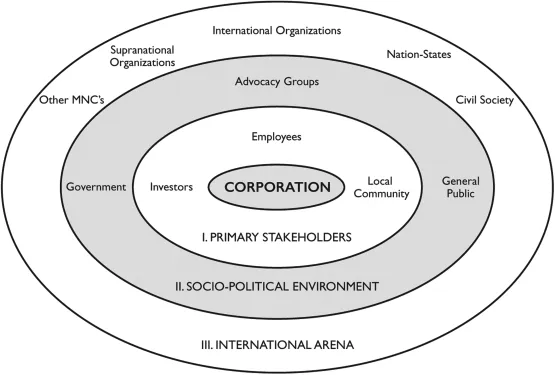
Corporate Communication
An International and Management Perspective
Otto Lerbinger
- English
- ePUB (handyfreundlich)
- Über iOS und Android verfügbar
Corporate Communication
An International and Management Perspective
Otto Lerbinger
Über dieses Buch
Provides an international and management perspective on the field of corporate communication
Corporate communication plays an important role in higher-level management to help build and preserve a company's reputation. This intangible yet valuable asset determines the net worth of a company and affects the success of its operations. Corporate Communication: An International and Management Perspective introduces readers to the broad environment of the modern extended organization and provides an understanding of the globalization process. It describes how economic, political, and cultural features of a country affect company decisions and communication and discusses various communication disciplines and practices that are employed in programs and campaigns. This book addresses the key management issues of sustainability and technology and innovation. It also emphasizes the importance of why corporate communication must be seen as a management function and not restricted to a communication process.
Presented in five parts, Corporate Communication offers comprehensive chapters covering: The Domain of Corporate Communication; Strategic Application of Communication Practices; International Perspective; Key Management Issues of Sustainability and Technology; and Corporate Communication Contribution to Management. The foundation of Corporate Communication is public relations but also included is the entire range of communication practices and the contribution to management decision making.
- Conceptualizes corporate communication as a strategic management function which helps management recognize, adjust to, and construct policy related to global issues
- Emphasizes the critical role that corporate communication plays in making corporate decisions and behaviors more socially responsible and sustainable
- Demonstrates how corporate communication draws on public affairs, marketing and social media in its strategic planning
- Emphasizes the critical importance of relationships to corporations and their effect on reputation
- Provides numerous examples of cases of global problems and how corporations have responded to them
Corporate Communicatio n is intended for upper-level undergraduate and graduate students in schools of communication and schools of business and management who want to extend their competence to the global arena and to combine the various communication practices to design strategic programs and campaigns. Course titles include corporate communication, international public relations, corporate public affairs, global marketing communication, global corporate communication, and social media.
Häufig gestellte Fragen
Information
Part I
The Extended Enterprise
The Extended Enterprise
- Zone 1: Primary Stakeholders. These have been the focus of public relations. They include investors who provide capital, employees who provide labor, and local communities that provide “land” and accompanying infrastructure. Collectively, they represent the economist's “factors of production.” These stakeholders are only partly reflected in a company's formal organization chart and balance sheet, which shows assets, liabilities, and capital (net worth). The organizational chart includes only managers and other employees. The balance sheet excludes employees as an asset even though they are as important as buildings and equipment that are listed.The factors of production are paid dividends and interest. Wages, and rents from the revenue flow from consumer. It was Chester Barnard who observed in his classic The Function of the Executive, that customers had not been included as part of a company even though they are essential to an enterprise's success.4 Public relations and corporate communication overcome this deficiency by recognizing all stakeholders, including consumers.
- Zone 2: Socio-Political Environment. This term is used by the Public Affairs Council, a Washington, DC professional society, to define public affairs. Included are government on all levels, advocacy groups, and the general public. The attitudes and actions of these constituents constitute a company's “license to operate.” The sociopolitical environment is especially important for companies that are highly regulated and are targets of advocacy groups.
- Zone 3: International Arena. This zone is of special importance to global corporate communication and includes other multi-national corporations (MNCs), supranational organizations such as the United Nations, international organizations such as the World Bank and International Monetry Fund, and other nation states.
